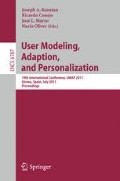Abstract
Our goal is to develop methods for non-experts to teach complex behaviors to autonomous agents (such as robots) by accommodating “natural” forms of human teaching. We built a prototype interface allowing humans to teach a simulated robot a complex task using several techniques and report the results of 44 human participants using this interface. We found that teaching styles varied considerably but can be roughly categorized based on the types of interaction, patterns of testing, and general organization of the lessons given by the teacher. Our study contributes to a better understanding of human teaching patterns and makes specific recommendations for future human-robot interaction systems.
Access this chapter
Tax calculation will be finalised at checkout
Purchases are for personal use only
Preview
Unable to display preview. Download preview PDF.
References
Argall, B., Chernova, S., Veloso, M.M., Browning, B.: A survey of robot learning from demonstration. Robotics and Autonomous Systems 57(5), 469–483 (2009)
Kaochar, T., Peralta, R.T., Morrison, C.T., Walsh, T.J., Fasel, I.R., Beyon, S., Tran, A., Wright, J., Cohen, P.R.: Human natural instruction of a simulated electronic student. In: AAAI Spring Symposium (2011)
Knox, W.B., Stone, P.: Combining manual feedback with subsequent mdp reward signals for reinforcement learning. In: AAMAS (2010)
Natarajan, S., Kunapuli, G., Maclin, R., Page, D., O’Reilly, C., Walker, T., Shavlik, J.: Learning from human teachers: Issues and challenges for ILP in bootstrap learning. In: AAMAS Workshop on Agents Learning Interactively from Human Teachers (2010)
Stumpf, S., Rajaram, V., Li, L., Wong, W.-K., Burnett, M., Dietterich, T., Sullivan, E., Herlocker, J.: Interacting meaningfully with machine learning systems: Three experiments. International Journal of Human-Computer Studies 67(8), 639–662 (2009)
Thomaz, A.L., Breazeal, C.: Teachable robots: Understanding human teaching behavior to build more effective robot learners. Artificial Intelligence 172(6-7), 716–737 (2008)
Walsh, T.J., Subramanian, K., Littman, M.L., Diuk, C.: Generalizing apprenticeship learning across hypothesis classes. In: ICML (2010)
Author information
Authors and Affiliations
Editor information
Editors and Affiliations
Rights and permissions
Copyright information
© 2011 Springer-Verlag Berlin Heidelberg
About this paper
Cite this paper
Kaochar, T., Peralta, R.T., Morrison, C.T., Fasel, I.R., Walsh, T.J., Cohen, P.R. (2011). Towards Understanding How Humans Teach Robots. In: Konstan, J.A., Conejo, R., Marzo, J.L., Oliver, N. (eds) User Modeling, Adaption and Personalization. UMAP 2011. Lecture Notes in Computer Science, vol 6787. Springer, Berlin, Heidelberg. https://doi.org/10.1007/978-3-642-22362-4_31
Download citation
DOI: https://doi.org/10.1007/978-3-642-22362-4_31
Publisher Name: Springer, Berlin, Heidelberg
Print ISBN: 978-3-642-22361-7
Online ISBN: 978-3-642-22362-4
eBook Packages: Computer ScienceComputer Science (R0)

